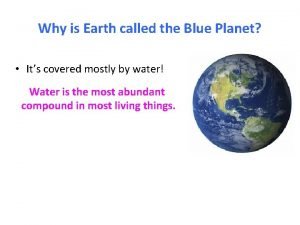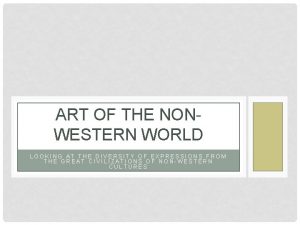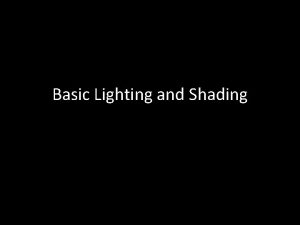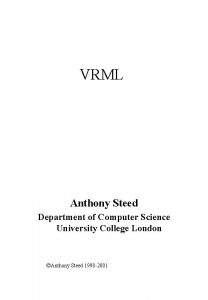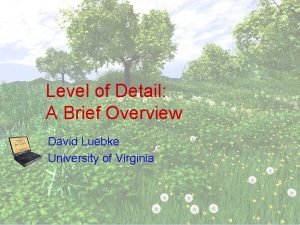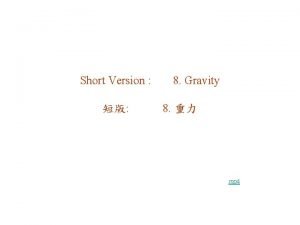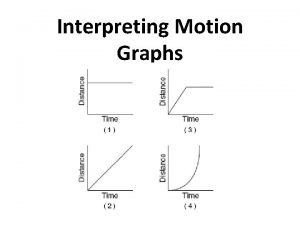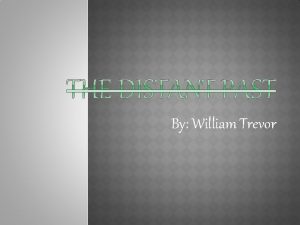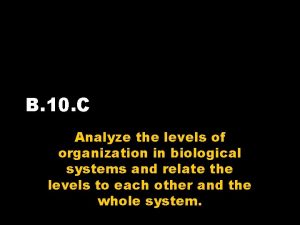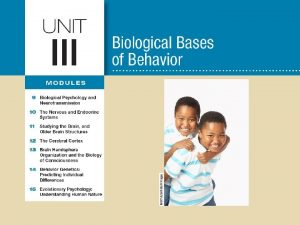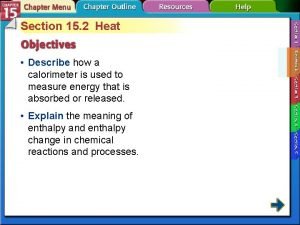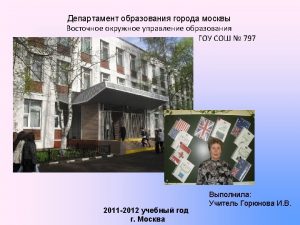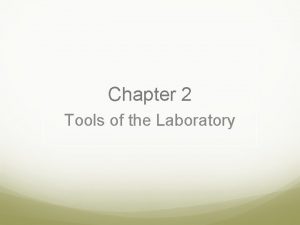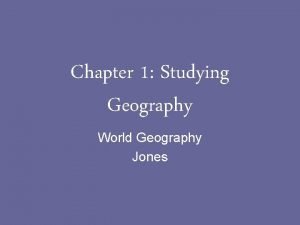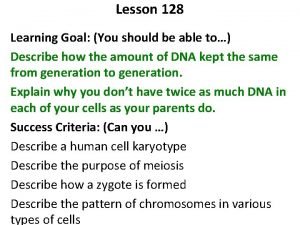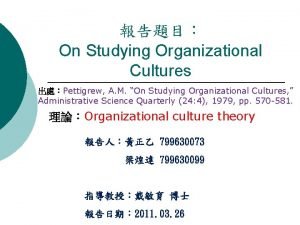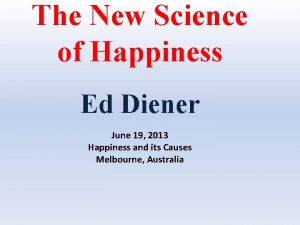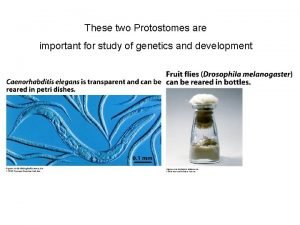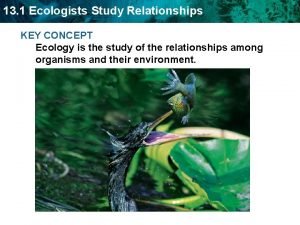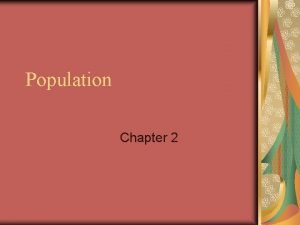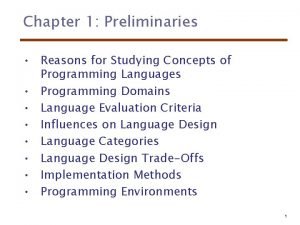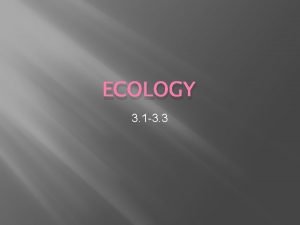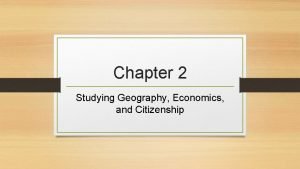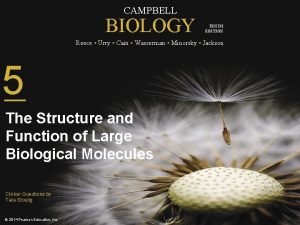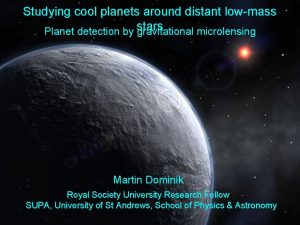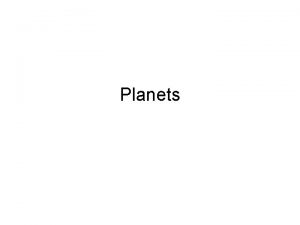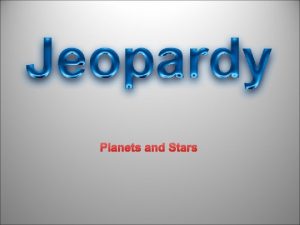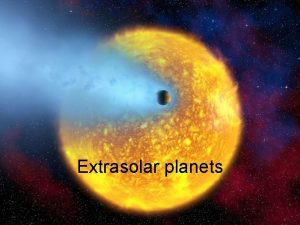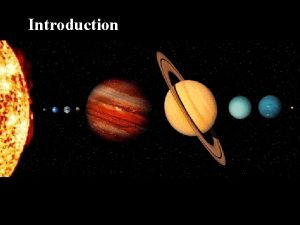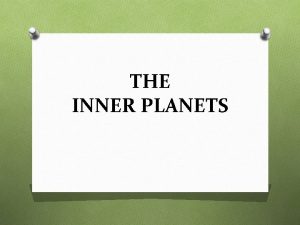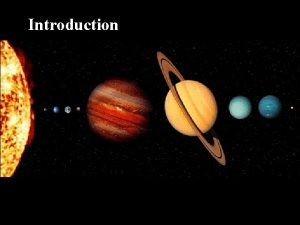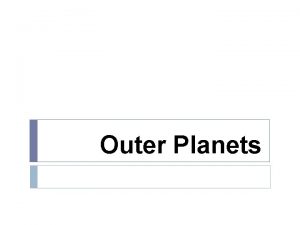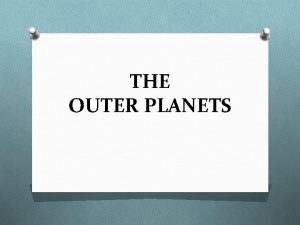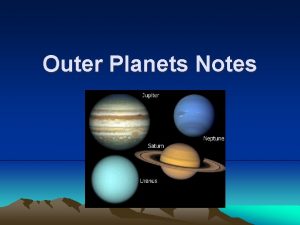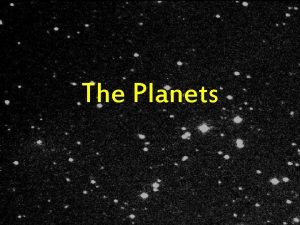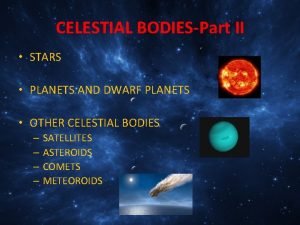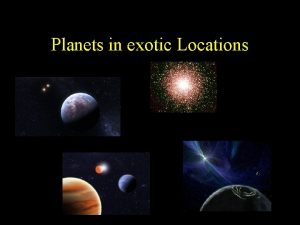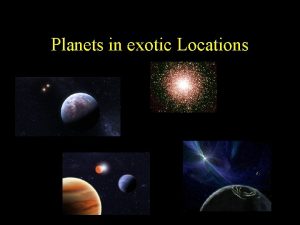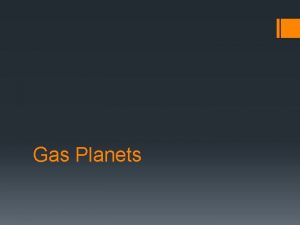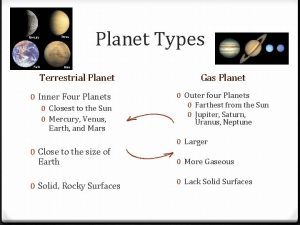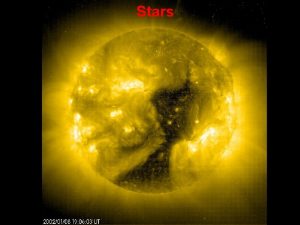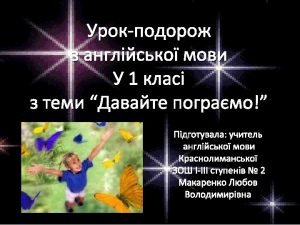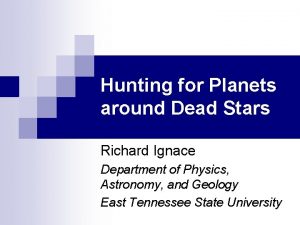Studying cool planets around distant lowmass stars Planet











































- Slides: 43

Studying cool planets around distant low-mass stars Planet detection by gravitational microlensing (Part II) Martin Dominik Royal Society University Research Fellow SUPA, University of St Andrews, School of Physics & Astronomy

Bending of starlight by stars (Gravitational microlensing) S L angular Einstein radius 4 GM DS−DL θE = c 2 DL DS ( ) 1/2 with ‘typical’ DS ~ 8. 5 kpc and DL ~ 6. 5 kpc θE ~ 600 (M/M☉ )1/2 μas

Bending of starlight by stars (Gravitational microlensing) S L (t-t 0)/t. E ~ 40 (M/M☉)1/2 days

Notes about gravitational lensing dated to 1912 on two pages of Einstein’s scratch notebook


First reported microlensing event MACHO LMC#1 Nature 365, 621 (October 1993)

Current microlensing surveys (2007) Optical Gravitational Lensing Experiment 1. 3 m Warsaw Telescope, Las Campanas (Chile) 1. 8 m MOA Telescope, Mt John (New Zealand) daily monitor ≳ 100 million stars, -6 τ ~ 10 for microlensing event → ~1000 events alerted per year

Planet detection by microlensing Bending of light due to gravitational field 4 GM α= c 2ξ 2. 5 t. E = 40 d Δmag 2 planetary ‘blip’ 1. 5 q = Mp/M✶, d = δ 0/θE θE = 1 ( 4 GM✶ DS−DL c 2 DL DS 1/2 ) 0. 5 0 -50 0 tt-t - 0 t 0[d] 50 adapted from M. M. Dominik (PLANETcollaboration), 2000, 50, 299 adapted from Dominik et et al. (PLANET P&SS 50, P&SS 299 (2002)

A round-the-clock follow-up network 1 -2% photometric precision 1. 5 - 2. 5 hr sampling bright stars (giants): 20 events at given time, 75 per season http: //planet. iap. fr Jupiters between 0. 6 and 1. 6 r. E : MACHO/OGLE-II (1999): ~ 100 alerts OGLE-III/MOA (2006): ~ 1000 alerts fainter stars: 6 events at given time, 20 per season ~ 15% detected in A 0 ≳ 1. 34 events ~ 80% detected in A 0 ≳ 10 events PLANET restricted (1999): ~ 3 f. J jupiters/year PLANET full capability: ~ 15 -25 f. J jupiters/year M. Dominik et al. (PLANET collaboration) 2002, P&SS 50, 299

PLANET planet detection efficiency 14 most favourable events from 2004 season preferred: m large a ~ 1— 4 AU d = δ 0/θE ~ 1 (“resonance”) θE = preliminary ( 4 GM DS−DL c 2 DL DS ) 1/2 RS ~ (few km) und D ~ (few kpc) gives r. E = DLθE ~ (few AU) duration Δt and probability of signal ~ q 1/2 signal amplitude only reduced by finite angular radius✶θ of source star for Δt ≲ 2 θ ✶ /μ

First planetary abundance limits from 42 events well-covered by PLANET 1995 -1999 1/4 1/3 1/2 2/3 3/4 ~ jupitermass f < 1/3 corresponds to 9 expected none observed f > f(d, q) ruled out at 95% C. L. M. Albrow et al. (PLANET collaboration), 2001, Ap. J 556, L 113

Survey detection efficiency for planets Cumulated planet detection efficiency 2002 OGLE-III data - 321 events m = mjup q = 10 -3 q = 10 -4 C. Snodgrass, K. Horne, & Y. Tsapras 2004, MNRAS, 351, 967 ~3% ~ 1. 5 %

The first microlensing planet OGLE 2003 -BLG-235 M ~ 1. 5 M ♃ MOA 2003 -BLG-53 t. E = 61. 5 d, d = 1. 12, q = 3. 9 × 10 -3, t✶= 0. 059 d θ✶= (0. 50 +/- 0. 05) μas I. A. Bond et al. (MOA and OGLE collaborations), 2004, Ap. J 606, L 155

. . and the second one OGLE 2005 -BLG-071 close binary t. E = 73. 9 d d = 0. 758 q = 6. 7 × 10 -3 wide binary t. E = 70. 9 d d = 1. 294 q = 7. 1 × 10 -3 M ~ 3 M♃ A. Udalski et al. (OGLE, Micro. FUN, MOA, and PLANET/Robo. Net collaborations), 2005, Ap. J 628, L 109

From Jupiters to Earths April 2004: “Earth-like planet search to start” Dominik: “If 20% of these stars are surrounded by planets, we expect to find 10 -15 giant planets and one or two Earth-sized worlds within three years. ”

Host stars and expected planet abundance Stellar mass probed by microlensing Ida S. , Lin D. N. C. , 2005, Ap. J 626, 1045

OGLE 2005 -BLG-390 True-colour image composed from BVI taken with Danish 1. 54 m at ESO La. Silla (PLANET collaboration)

OGLE 2005 -BLG-390 Image taken with Danish 1. 54 m at ESO La. Silla, convolved with model light curve (animation by Daniel Kubas)

OGLE 2005 -BLG-390 31 -Jul 10 -Aug J. -P. Beaulieu, D. P. Bennett, P. Fouqué, A. Williams, M. Dominik, and 68 others (PLANET/Robo. Net, OGLE, and MOA collaborations), 2006, Nature 439, 437

OGLE-2005 -BLG-390 magnification map Einstein ring source trajectory map by Aarno Korpela, animation by Martin Dominik


Mp = 5. 5 M♁ (2. 1), M✶= 0. 22 M☉ (2. 1), a = 2. 9 AU (1. 6), P = 10. 4 yr (2. 0), μ= ✶ mas/yr, θE =Rμ t. E = 210 μas θ /t. D✶L==7(0. 85 ± 0. 15) GC RP ~ 2. 4 R♁, g. P ~ 0. 9 g♁ (for ρ=ρ♇ ) J. -P. Beaulieu, D. P. Bennett, P. Fouqué, A. Williams, M. Dominik, and 68 others, (PLANET/Robo. Net, OGLE, and MOA collaborations), 2006, Nature 439, 437 M. Dominik, 2006, MNRAS 367, 669

Artist’s impression of OGLE-2005 -BLG-390 Lb © ESO

Exoplanet discovery space figure courtesy of K. Horne

Approaching the habitable zone transits cro len sin g y t i c o l e v l a i rad mi http: //www. ibiblio. org/astrobiology (follows J. F. Kasting, D. P. Whitmire, R. T. Reynolds, 1993, Icarus 101, 108)

informal consortium, involving amateur astronomers only observe highly-promising close-alignment events OGLE 2005 -BLG-169 M ~ 13 M♁ A. Gould et al. , 2006, Ap. J 644, L 37

Exoplanet discovery space (II) figure courtesy of K. Horne

Detections and planetary abundance Distribution of planets (simulation) Average detection efficiency 14 prime events - PLANET 2004 Microlensing detections Ida S. , Lin D. N. C. , 2005, Ap. J 626, 1045 A. Cassan, D. Kubas, M. Dominik et al. (PLANET collaboration), in preparation

Robo. Net 1. 0 2. 0 m robotic telescopes, funded by http: //www. astro. livjm. ac. uk Common PLANET/Robo. Net microlensing campaign since 2005


d = 1. 61 t. E = 11. 0 d u 0 = 0. 359 simulated data

simulated data

d = 1. 61 t. E = 11. 0 d u 0 = 0. 359 simulated data

d = 1. 61 t. E = 11. 0 d u 0 = 0. 359 simulated data

Planet with 0. 1 Earth masses d = 1. 2 t. E = 11. 0 d u 0 = 0. 359

Microlensing live Optical Gravitational Lensing Experiment Robo. Net 1. 0 SIGNALMEN light curve plotter continue





Future projects (I) Automated Robotic Terrestrial Exoplanet MIcrolensing Search A possible expert-system based cooperative effort to hunt for planets of Earth mass and below M. Dominik, K. Horne, A. Allan, N. J. Rattenbury, Y. Tsapras, C. Snodgrass et al.

Future projects (II) GAlactic BAR Infrared Time-domain Survey (GABARIT) A UKIRT Large Project Proposal E. Kerins et al.

Planets detected by microlensing 2007 2006 2010 2009 2008 ( ) NOT The End
 What is each planet made of
What is each planet made of Inner planets and outer planets
Inner planets and outer planets The first four outer planets do not have solid
The first four outer planets do not have solid What are jovian planets made of
What are jovian planets made of What separates the inner and outer planets?
What separates the inner and outer planets? Studying our living planet
Studying our living planet The rwenzori mountains mary daniels is a student in england
The rwenzori mountains mary daniels is a student in england Why is earth called a blue planet
Why is earth called a blue planet Goes around comes around meaning
Goes around comes around meaning What goes around comes around examples
What goes around comes around examples Bare willows and distant mountains
Bare willows and distant mountains Distant
Distant Distant
Distant Aims are
Aims are Cannibal inhabitants of a distant land
Cannibal inhabitants of a distant land Distant
Distant Retrograde motion of mars
Retrograde motion of mars Peace is not merely a distant goal
Peace is not merely a distant goal His shadow shouts on a nightmare scream meaning
His shadow shouts on a nightmare scream meaning Always-on
Always-on Distant past tense
Distant past tense A student is studying the ecology of a playa lake
A student is studying the ecology of a playa lake 8 importance of literature review
8 importance of literature review Module 11 studying the brain and older brain structures
Module 11 studying the brain and older brain structures Jumma rakat
Jumma rakat Why are chemists interested in studying thermochemistry?
Why are chemists interested in studying thermochemistry? Imagine you are studying english
Imagine you are studying english The five i's of studying microorganisms
The five i's of studying microorganisms When criticizing functional objects
When criticizing functional objects Researchers who are studying a new shampoo
Researchers who are studying a new shampoo Lesson 1 studying geography
Lesson 1 studying geography Active recall and spaced repetition
Active recall and spaced repetition Culture or way of living station 1
Culture or way of living station 1 Studying in sweden as an eu citizen
Studying in sweden as an eu citizen Edgar schein 3 levels of culture
Edgar schein 3 levels of culture Studying in united kingdom
Studying in united kingdom Importance of studying protostomes
Importance of studying protostomes What do ecologists study
What do ecologists study Importance of studying population
Importance of studying population Reasons for studying concepts of programming languages
Reasons for studying concepts of programming languages Studying
Studying Chapter 2 lesson 1 studying geography
Chapter 2 lesson 1 studying geography A student is studying the ecology of a playa lake
A student is studying the ecology of a playa lake A polysaccharide you are studying contains unbranched
A polysaccharide you are studying contains unbranched







